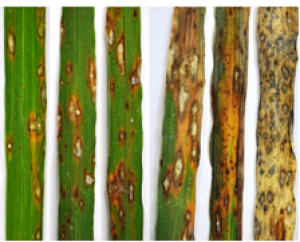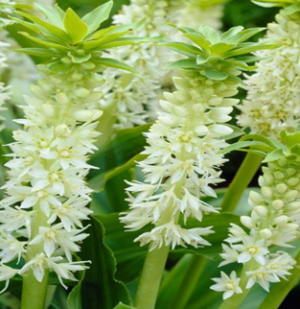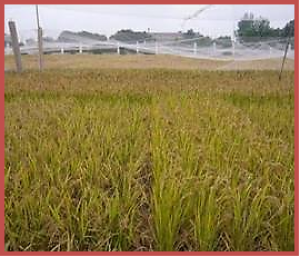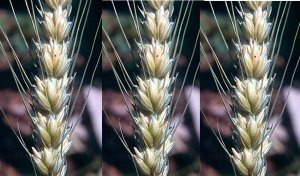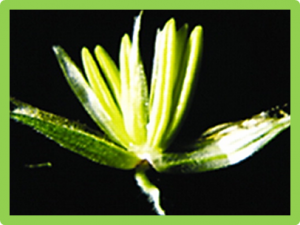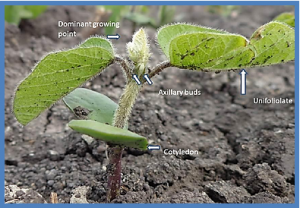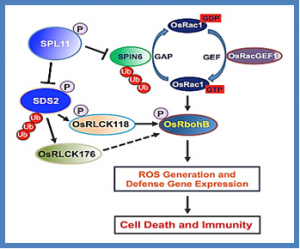Rice blast disease caused by Magnaporthe oryzae is the most devastating disease of rice. Previous studies have identified a terpene synthase gene, OsTPS19, as a candidate defense gene. The team of Xujun Chen from China Agricultural University studied OsTPS19, which was found to be upregulated by M. oryzae infection.The team found that overexpression of the OsTPS19 gene in rice plants enhanced the plants' resistance against rice blast. On the other hand, OsTPS19 RNAi-silenced lines were found more susceptible to the disease.
Drought stress has adverse effects on growth, water relations, photosynthesis and yield of groundnut. WRKY transcription factors (TFs) are the plant-specific TFs which regulate several down-stream stress-responsive genes and play an essential role in plant biotic and abiotic stress responses. We found that WRKY3 gene is highly up-regulated under drought stress conditions and therefore isolated a new WRKY3TF gene from a drought-adapted horsegram (Macrotyloma uniflorum Lam. Verdc.).
Biopolymers have become increasingly popular as biostimulators of plant growth. One of them, oligo-alginate, is a molecule that regulates plant biological processes and may be used in horticultural practice as a plant growth regulator. Biostimulators are mainly used to improve plant tolerance to abiotic stresses, including salinity. The aim of the study was to assess the effects of salinity and oligo-alginate of various molecular masses on the growth and physiological activity of Eucomis autumnalis.
Drought is the most important factor limiting rice yield in most rainfed areas of Asia and Africa. Four large BC2F2 populations consisted of 3,200 individuals, which were derived from crosses between an elite Geng variety, Jigeng88, and four donors from three different countries, were screened and progeny tested under severe drought stress, resulting in the development of 72 introgression lines (ILs) with significantly improved yield compared to the recurrent parent Jigeng88.
Soybean resistance to sudden death syndrome (SDS) is composed of foliar resistance to phytotoxins and root resistance to pathogen invasion. There are more than 80 quantitative trait loci (QTL) and dozens of single nucleotide polymorphisms (SNPs) associated with soybean resistance to SDS. The validity of these QTL and SNPs is questionable because of the complexity in phenotyping methodologies, the disease synergism between SDS and soybean cyst nematode (SCN),
This study aimed to advance our understanding of the genetic mechanisms underlying morphological traits of the flag leaves of wheat (Triticum aestivum L.). A recombinant inbred line (RIL) population derived from ND3331 and the Tibetan semi-wild wheat Zang1817 was used to identify quantitative trait loci (QTLs) controlling flag leaf length (FLL), flag leaf width (FLW), flag leaf area (FLA), and flag leaf angle (FLANG). Using an available simple sequence repeat genetic linkage map
The NAM, ATAF1/2, and CUC2 (NAC) transcription factors form a large plant-specific gene family, which is involved in the regulation of tissue development in response to biotic and abiotic stress. To date, there have been no comprehensive studies investigating chromosomal location, gene structure, gene phylogeny, conserved motifs, or gene expression of NAC in pepper (Capsicum annuum L.).
Previous studies revealed that the promoters for driving both Cas9 and sgRNAs are quite important for efficient genome editing by CRISPR/Cas9 in plants. Here we report our results of targeted genome editing using the maize dmc1 gene promoter combined with the U3 promoter for Cas9 and sgRNA, respectively. Three loci in the maize genome were selected for targeting. The T0 plants regenerated were highly‐efficiently edited at the target sites with homozygous or bi‐allelic mutants accounting for about 66%.
To understand translational capacity on a genome-wide scale across three developmental stages of immature soybean seed cotyledons, ribosome profiling was performed in combination with RNA sequencing and cluster analysis. Transcripts representing 216 unique genes demonstrated a higher level of translational activity in at least one stage by exhibiting higher translational efficiencies (TEs) in which there were relatively more ribosome footprint sequence reads mapping to the transcript than were present in the control total RNA sample.
Programmed cell death (PCD) plays critical roles in plant immunity but must be regulated to prevent excessive damage. The E3 ubiquitin ligase SPL11 negatively regulates PCD and immunity in plants. We show that SPL11 cell-death suppressor 2 (SDS2), an S-domain receptor-like kinase, positively regulates PCD and immunity in rice by engaging and regulating SPL11 and related kinases controlling defense responses.


 Curently online :
Curently online :
 Total visitors :
Total visitors :
